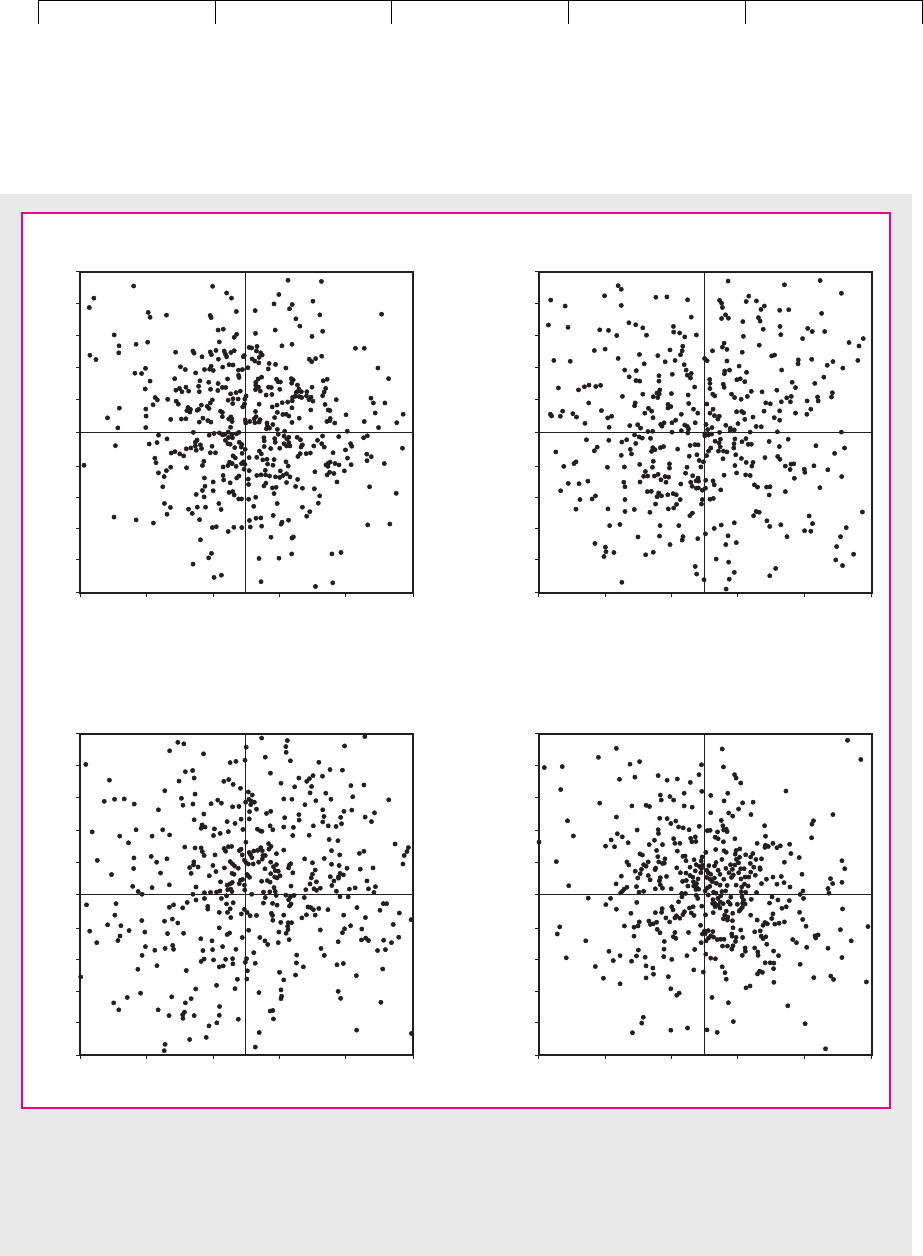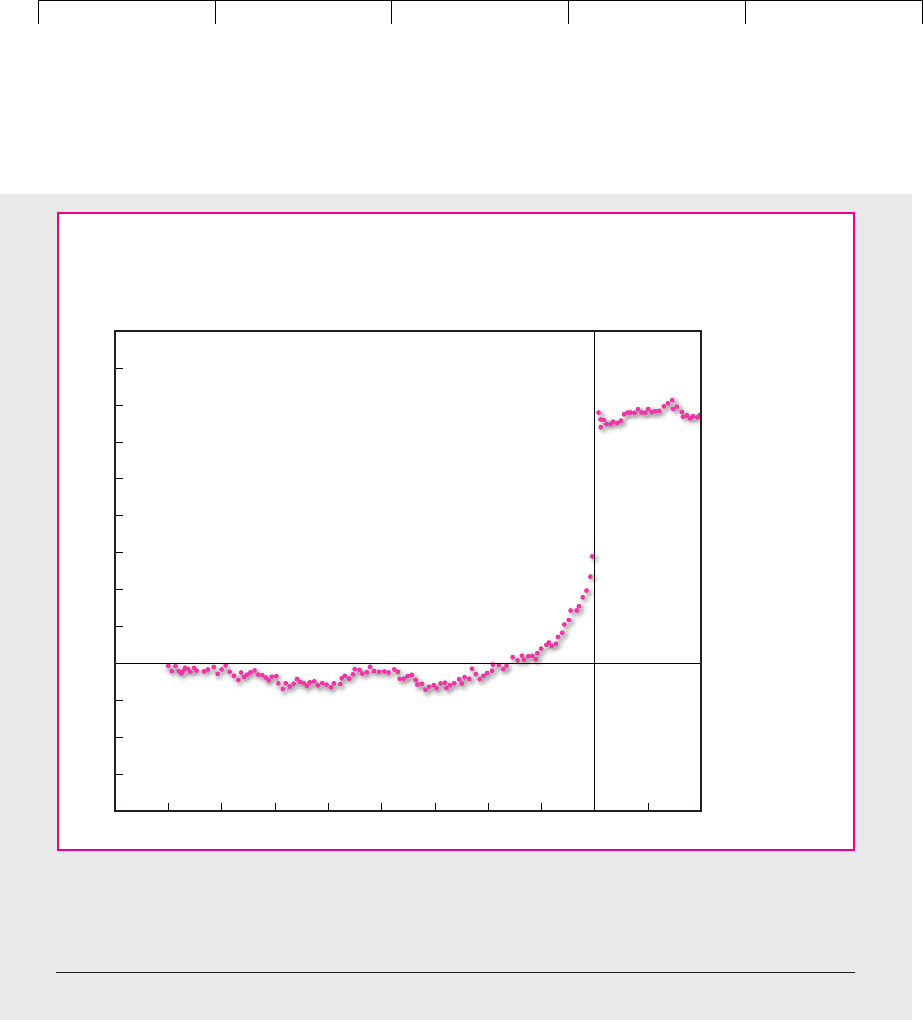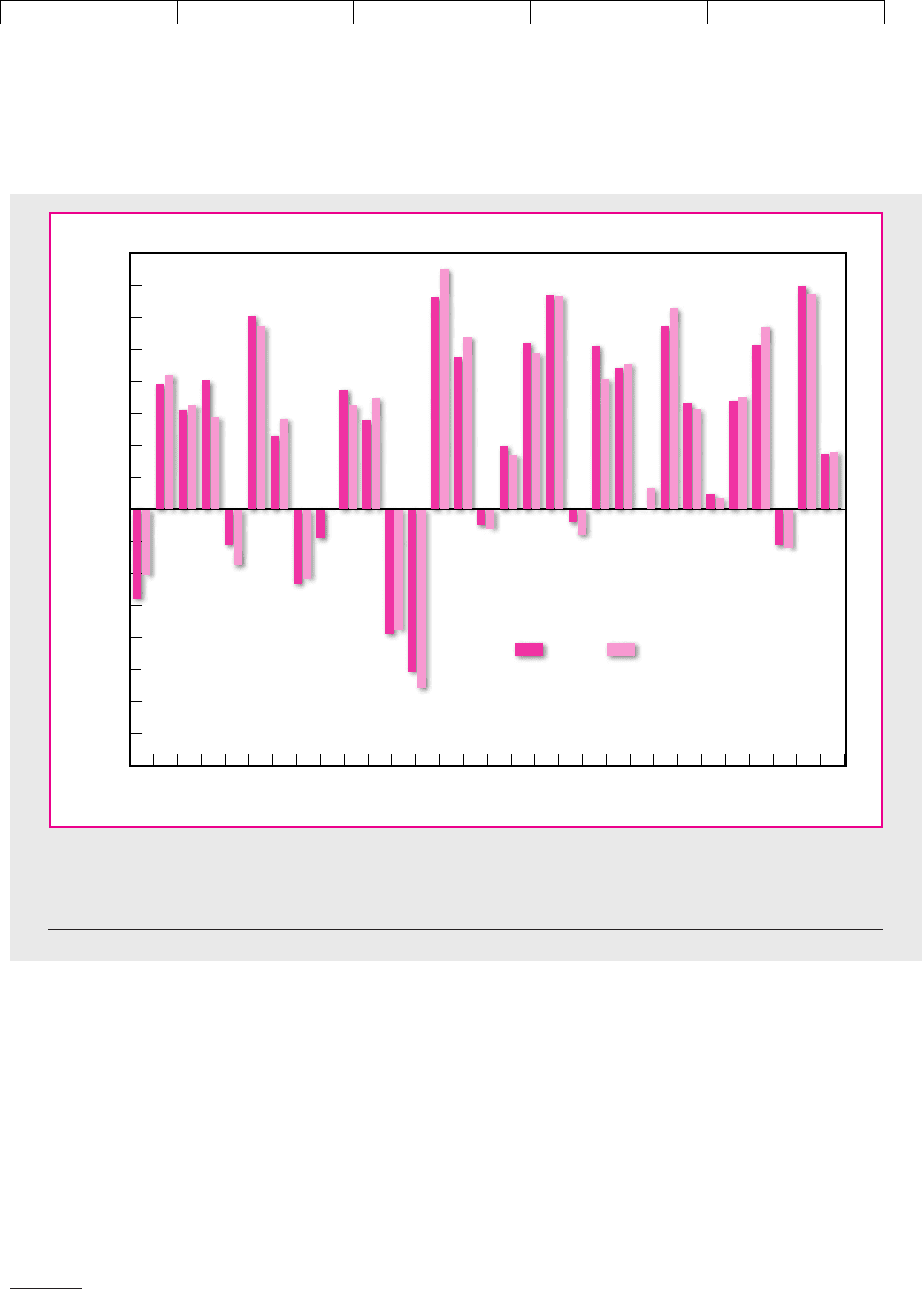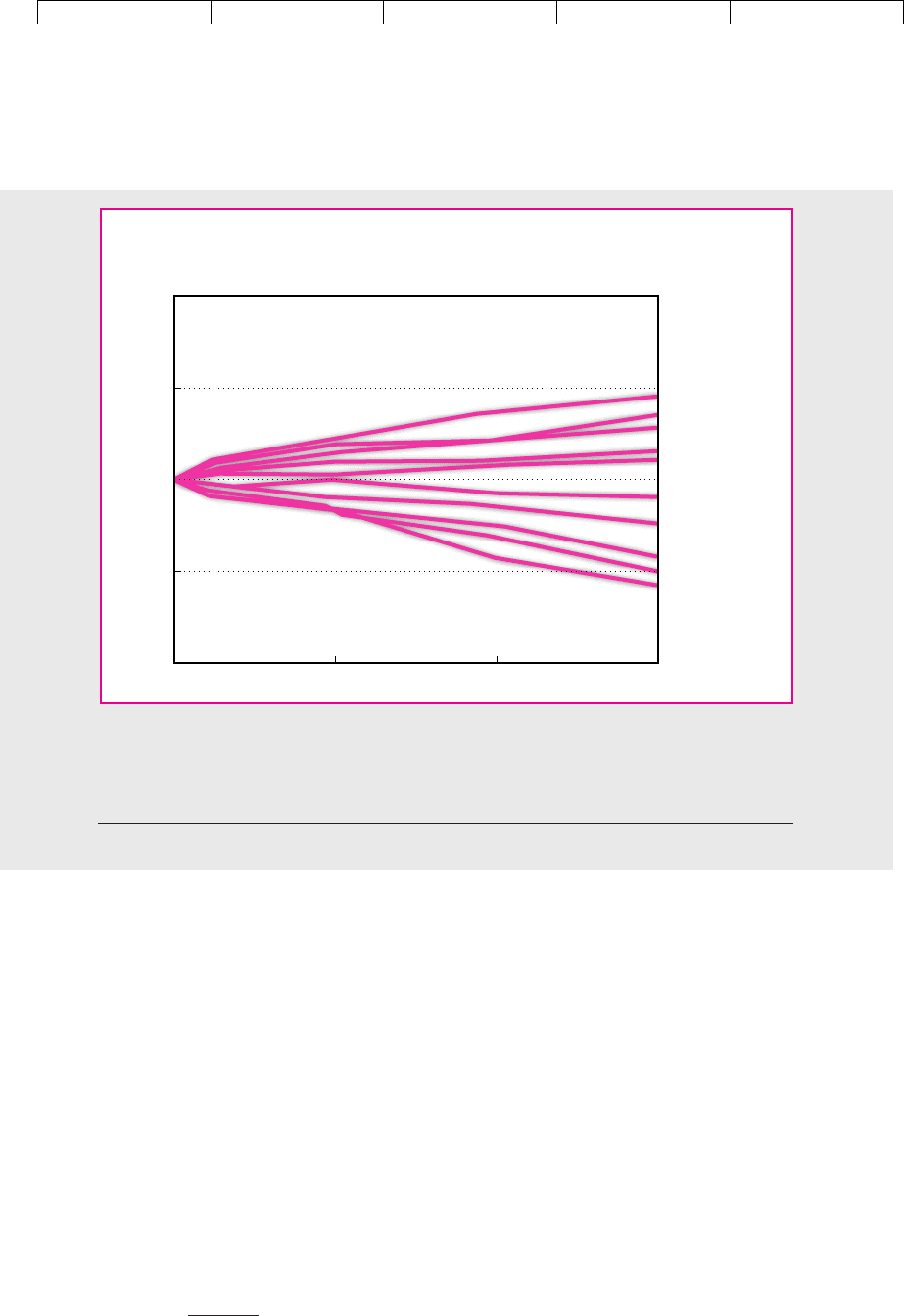Brealey, Myers. Principles of Corporate Finance. 7th edition
Подождите немного. Документ загружается.


Brealey−Meyers:
Principles of Corporate
Finance, Seventh Edition
IV. Financial Decisions and
Market Efficiency
13. Corporate Financing
and the Six Lessons of
Market Efficiency
© The McGraw−Hill
Companies, 2003
upswing in Microsoft’s stock price started last month, when the price was $50,
and it is expected to carry the price to $90 next month. What will happen when in-
vestors perceive this bonanza? It will self-destruct. Since Microsoft stock is a bar-
gain at $70, investors will rush to buy. They will stop buying only when the stock
offers a normal rate of return. Therefore, as soon as a cycle becomes apparent to
investors, they immediately eliminate it by their trading.
350 PART IV
Financing Decisions and Market Efficiency
–5
–5
–4
–3
–2
–1
0
1
2
3
4
5
–3 –1 1 3 5
Return on day
t
, percent
Return on day
t
+ 1, percent
FIGURE 13.2
Each dot shows a pair of returns for Microsoft stock
on two successive days between March 1990 and
July 2001. The circled dot records a daily return of
⫹1 percent and then ⫺1 percent on the next day.
The scatter diagram shows no significant relation-
ship between returns on successive days.
Microsoft's stock price
Time
$90
70
50
Last
month
Upswing
Actual price
as soon as
upswing is
recognized
This
month
Next
month
FIGURE 13.3
Cycles self-destruct as soon
as they are recognized by
investors. The stock price
instantaneously jumps to the
present value of the expected
future price.

Brealey−Meyers:
Principles of Corporate
Finance, Seventh Edition
IV. Financial Decisions and
Market Efficiency
13. Corporate Financing
and the Six Lessons of
Market Efficiency
© The McGraw−Hill
Companies, 2003
Three Forms of Market Efficiency
You should see now why prices in competitive markets must follow a random
walk. If past price changes could be used to predict future price changes, investors
could make easy profits. But in competitive markets easy profits don’t last. As in-
vestors try to take advantage of the information in past prices, prices adjust im-
mediately until the superior profits from studying past price movements disap-
pear. As a result, all the information in past prices will be reflected in today’s stock
price, not tomorrow’s. Patterns in prices will no longer exist and price changes in
one period will be independent of changes in the next. In other words, the share
price will follow a random walk.
In competitive markets today’s stock price must already reflect the information
in past prices. But why stop there? If markets are competitive, shouldn’t today’s
stock price reflect all the information that is available to investors? If so, securities
will be fairly priced and security returns will be unpredictable, whatever informa-
tion you consider.
Economists often define three levels of market efficiency, which are distin-
guished by the degree of information reflected in security prices. In the first level,
prices reflect the information contained in the record of past prices. This is called
the weak form of efficiency. If markets are efficient in the weak sense, then it is im-
possible to make consistently superior profits by studying past returns. Prices will
follow a random walk.
The second level of efficiency requires that prices reflect not just past prices but
all other published information, such as you might get from reading the financial
press. This is known as the semistrong form of market efficiency. If markets are ef-
ficient in this sense, then prices will adjust immediately to public information such
as the announcement of the last quarter’s earnings, a new issue of stock, a proposal
to merge two companies, and so on.
Finally, we might envisage a strong form of efficiency, in which prices reflect
all the information that can be acquired by painstaking analysis of the company
and the economy. In such a market we would observe lucky and unlucky in-
vestors, but we wouldn’t find any superior investment managers who can con-
sistently beat the market.
Efficient Markets: The Evidence
In the years that followed Maurice Kendall’s discovery, financial journals were
packed with tests of the efficient-market hypothesis. To test the weak form of the
hypothesis, researchers measured the profitability of some of the trading rules
used by those investors who claim to find patterns in security prices. They also em-
ployed statistical tests such as the one that we described when looking for patterns
in the returns on Microsoft stock. For example, in Figure 13.4 we have used the
same test to look for relationships between stock market returns in successive
weeks. It appears that throughout the world there are few patterns in week-to-
week returns.
To analyze the semistrong form of the efficient-market hypothesis, researchers
have measured how rapidly security prices respond to different items of news,
such as earnings or dividend announcements, news of a takeover, or macroeco-
nomic information.
Before we describe what they found, we should explain how to isolate the effect
of an announcement on the price of a stock. Suppose, for example, that you need
CHAPTER 13
Corporate Financing and the Six Lessons of Market Efficiency 351

Brealey−Meyers:
Principles of Corporate
Finance, Seventh Edition
IV. Financial Decisions and
Market Efficiency
13. Corporate Financing
and the Six Lessons of
Market Efficiency
© The McGraw−Hill
Companies, 2003
to know how the stock price responds to news of a takeover. As a first stab, you
could look at the returns on the stock in the months surrounding the announce-
ment. But that would provide a very noisy measure, for the price would reflect
among other things what was happening to the market as a whole. A second pos-
sibility would be to calculate a measure of relative performance.
352 PART IV
Financing Decisions and Market Efficiency
–5
–5
–4
–3
–2
–1
0
1
2
3
4
5
–3 –1 1 3 5
Return in week
t
, percent
Return in week
t
+1, percent
FTSE 100
(correlation = –.09)
–5
–5
–4
–3
–2
–1
0
1
2
3
4
5
–3 –1 1 3 5
Return in week
t
, percent
Return in week
t
+1, percent
Nikkei 500
(correlation = –.03)
–5
–5
–4
–3
–2
–1
0
1
2
3
4
5
–3 –1 1 3 5
Return in week
t
, percent
Return in week
t
+1, percent
DAX 30
(correlation = –.01)
–5
–5
–4
–3
–2
–1
0
1
2
3
4
5
–3 –1 1 3 5
Return in week
t
, percent
Return in week
t
+1, percent
Standard & Poor's Composite
(correlation = –.16)
FIGURE 13.4
Each point in these scatter diagrams shows the return in successive weeks on four stock market indexes between
September 1991 and July 2001. The wide scatter of points shows that there is almost no correlation between the return
in one week and in the next. The four indexes are FTSE 100 (UK), the Nikkei 500 (Japan), DAX 30 (Germany), and
Standard & Poor’s Composite (USA).

Brealey−Meyers:
Principles of Corporate
Finance, Seventh Edition
IV. Financial Decisions and
Market Efficiency
13. Corporate Financing
and the Six Lessons of
Market Efficiency
© The McGraw−Hill
Companies, 2003
Relative stock return ⫽ return on stock ⫺ return on market index
This is almost certainly better than simply looking at the returns on the stock. How-
ever, if you are concerned with performance over a period of several months or
years, it would be preferable to recognize that fluctuations in the market have a
larger effect on some stocks than others. For example, past experience might sug-
gest that a change in the market index affected the value of a stock as follows:
Expected stock return ⫽␣⫹⫻return on market index
6
Alpha (␣) states how much on average the stock price changed when the market
index was unchanged. Beta () tells us how much extra the stock price moved for
each 1 percent change in the market index.
7
Suppose that subsequently the stock
price provides a return of
˜
r in a month when the market return is
˜
r
m
. In that case
we would conclude that the abnormal return for that month is
Abnormal stock return ⫽ actual stock return ⫺ expected stock return
⫽
˜
r ⫺ (␣⫹
˜
r
m
)
This abnormal return abstracts from the fluctuations in the stock price that result
from marketwide influences.
8
Figure 13.5 illustrates how the release of news affects abnormal returns. The graph
shows the price run-up of a sample of 194 firms that were targets of takeover at-
tempts. In most takeovers, the acquiring firm is willing to pay a large premium over
the current market price of the acquired firm; therefore when a firm becomes the tar-
get of a takeover attempt, its stock price increases in anticipation of the takeover
premium. Figure 13.5 shows that on the day the public become aware of a takeover
attempt (Day 0 in the graph), the stock price of the typical target takes a big upward
jump. The adjustment in stock price is immediate: After the big price move on the
public announcement day, the run-up is over, and there is no further drift in the stock
price, either upward or downward.
9
Thus within the day, the new stock prices ap-
parently reflect (at least on average) the magnitude of the takeover premium.
A study by Patell and Wolfson shows just how fast prices move when new in-
formation becomes available.
10
They found that, when a firm publishes its latest
earnings or announces a dividend change, the major part of the adjustment in price
occurs within 5 to 10 minutes of the announcement.
CHAPTER 13 Corporate Financing and the Six Lessons of Market Efficiency 353
6
This relationship is often referred to as the market model.
7
It is important when estimating ␣ and  that you choose a period in which you believe that the stock
behaved normally. If its performance was abnormal, then estimates of ␣ and  cannot be used to mea-
sure the returns that investors expected. As a precaution, ask yourself whether your estimates of ex-
pected returns look sensible. Methods for estimating abnormal returns are analyzed in S. J. Brown and
J. B. Warner, “Measuring Security Performance,” Journal of Financial Economics 8 (1980), pp. 205–258.
8
The market is not the only common influence on stock prices. For example, in Section 8.4 we described
the Fama–French three-factor model, which states that a stock’s return is influenced by three common
factors—the market factor, a size factor, and a book-to-market factor. In this case we would calculate the
expected stock return as a ⫹ b
market
(
˜
r
market factor
) ⫹ b
size
(
˜
r
size factor
) ⫹ b
book-to-market
(
˜
r
book-to-market factor
).
9
See A. Keown and J. Pinkerton, “Merger Announcements and Insider Trading Activity,” Journal of Fi-
nance 36 (September 1981), pp. 855–869. Note that prices on the days before the public announcement do
show evidence of a sustained upward drift. This is evidence of a gradual leakage of information about
a possible takeover attempt. Some investors begin to purchase the target firm in anticipation of a pub-
lic announcement. Consistent with efficient markets, however, once the information becomes public, it
is reflected fully and immediately in stock prices.
10
See J. M. Patell and M. A. Wolfson, “The Intraday Speed of Adjustment of Stock Prices to Earnings
and Dividend Announcements,” Journal of Financial Economics 13 (June 1984), pp. 223–252.

Brealey−Meyers:
Principles of Corporate
Finance, Seventh Edition
IV. Financial Decisions and
Market Efficiency
13. Corporate Financing
and the Six Lessons of
Market Efficiency
© The McGraw−Hill
Companies, 2003
Tests of the strong form of the hypothesis have examined the recommendations of
professional security analysts and have looked for mutual funds or pension funds
that could predictably outperform the market. Some researchers have found a slight
persistent outperformance, but just as many have concluded that professionally man-
aged funds fail to recoup the costs of management. Look, for example, at Figure 13.6,
which is taken from a study by Mark Carhart of the average return on nearly
1,500 U.S. mutual funds. You can see that in some years the mutual funds beat the
market, but as often as not it was the other way around. Figure 13.6 provides a fairly
crude comparison, for mutual funds have tended to specialize in particular sectors of
the market, such as low-beta stocks or large-firm stocks, that may have given below-
average returns. To control for such differences, each fund needs to be compared with
a benchmark portfolio of similar securities. The study by Mark Carhart did this, but
the message was unchanged: The funds earned a lower return than the benchmark
portfolios after expenses and roughly matched the benchmarks before expenses.
354 PART IV
Financing Decisions and Market Efficiency
36
32
28
24
20
16
12
8
4
0
–4
–8
–12
–16
–135 –120 –105 –90 –75 –60 –45 –30 30–15 0 15
Cumulative
abnormal
return,
percent
Days relative to
announcement
date
FIGURE 13.5
The performance of the stocks of target companies compared with that of the market. The prices of target
stocks jump up on the announcement day, but from then on, there are no unusual price movements. The
announcement of the takeover attempt seems to be fully reflected in the stock price on the announcement day.
Source: A. Keown and J. Pinkerton, “Merger Announcements and Insider Trading Activity,” Journal of Finance 36 (September
1981), pp. 855–869.

Brealey−Meyers:
Principles of Corporate
Finance, Seventh Edition
IV. Financial Decisions and
Market Efficiency
13. Corporate Financing
and the Six Lessons of
Market Efficiency
© The McGraw−Hill
Companies, 2003
It would be surprising if some managers were not smarter than others and could
earn superior returns. But it seems difficult to spot the smart ones, and the top-
performing managers one year have about an average chance of falling on their
face the next year. For example, Forbes Magazine, a widely read investment period-
ical, has published annually since 1975 an “honor roll” of the most consistently
successful mutual funds. Suppose that each year, when Forbes announced its honor
roll, you had invested an equal sum in each of these exceptional funds. You would
have outperformed the market in only 5 of the following 16 years, and your aver-
age annual return before paying any initial fees would have been more than 1 per-
cent below the return on the market.
11
CHAPTER 13 Corporate Financing and the Six Lessons of Market Efficiency 355
–30
–20
–25
–15
–10
–35
–5
0
10
5
15
20
25
35
40
Returns, percent
30
Funds
Market
19921962 1967 1972 1977
Year
1982 1987
FIGURE 13.6
Average annual returns on 1,493 U.S. mutual funds and the market index, 1962–1992. Notice that mutual funds
underperform the market in approximately half the years.
Source: M. M. Carhart, “On Persistence in Mutual Fund Performance,” Journal of Finance 52 (March 1997), pp. 57–82.
11
See B. G. Malkiel, “Returns from Investing in Equity Mutual Funds 1971 to 1991,” Journal of Finance 50
(June 1995), pp. 549–572. It seems to be difficult to measure whether good performance does persist.
Some contrary evidence is provided in E. J. Elton, M. J. Gruber, and C. R. Blake, “The Persistence of Risk-
Adjusted Mutual Fund Performance,” Journal of Business 69 (April 1996), pp. 133–157. There is, however,
widespread agreement that the worst performing funds continue to underperform. That is not surpris-
ing, for they are shrinking and the costs of running them are proportionately higher.

Brealey−Meyers:
Principles of Corporate
Finance, Seventh Edition
IV. Financial Decisions and
Market Efficiency
13. Corporate Financing
and the Six Lessons of
Market Efficiency
© The McGraw−Hill
Companies, 2003
Such evidence on strong-form efficiency has proved to be sufficiently convinc-
ing that many professionally managed funds have given up the pursuit of superior
performance. They simply “buy the index,” which maximizes diversification and
minimizes the costs of managing the portfolio. Corporate pension plans now in-
vest over a quarter of their United States equity holdings in index funds.
356 PART IV
Financing Decisions and Market Efficiency
13.3 PUZZLES AND ANOMALIES—WHAT DO THEY
MEAN FOR THE FINANCIAL MANAGER?
Almost without exception, early researchers concluded that the efficient-market
hypothesis was a remarkably good description of reality. So powerful was the
evidence that any dissenting research was regarded with suspicion. But eventu-
ally the readers of finance journals grew weary of hearing the same message.
The interesting articles became those that turned up some puzzle. Soon the jour-
nals were packed with evidence of anomalies that investors have apparently
failed to exploit.
We have already referred to one such puzzle—the abnormally high returns on
the stocks of small firms. For example, look back at Figure 7.1, which shows the re-
sults of investing $1 in 1926 in the stocks of either small or large firms. (Notice that
the portfolio values are plotted in Figure 7.1 on a logarithmic scale.) By 2000 the $1
invested in small company stocks had appreciated to $6,402, while the investment
in large firms was worth only $2,587.
12
Although small firms had higher betas, the
difference was not nearly large enough to explain the difference in returns.
Now this may mean one (or more) of three things. First, it could be that in-
vestors have demanded a higher expected return from small firms to compensate
for some extra risk factor that is not captured in the simple capital asset pricing
model. That is why we asked in Chapter 8 whether the small-firm effect is evi-
dence against the CAPM.
Second, the superior performance of small firms could simply be a coincidence,
a finding that stems from the efforts of many researchers to find interesting pat-
terns in the data. There is evidence for and against the coincidence theory. Those
who believe that the small-firm effect is a pervasive phenomenon can point to the
fact that small-firm stocks have provided a higher return in many other countries.
On the other hand, you can see from Figure 7.1 that the superior performance of
small-firm stocks in the United States is limited to a relatively short period. Until
the early 1960s small-firm and large-firm stocks were neck and neck. A wide gap
then opened in the next two decades but it narrowed again in the 1980s when the
small-firm effect first became known. If you looked simply at recent years, you
might judge that there is a large-firm effect.
The third possibility is that we have here an important exception to the efficient-
market theory, one that provided investors with an opportunity to make pre-
dictably superior profits over a period of two decades. If such anomalies offer easy
pickings, you would expect to find a number of investors eager to take advantage
of them. It turns out that, while many investors do try to exploit such anomalies, it
is surprisingly difficult to get rich by doing so. For example, Professor Richard Roll,
who probably knows as much as anyone about market anomalies, confesses
12
In each case the portfolio values assume that dividends are reinvested.

Brealey−Meyers:
Principles of Corporate
Finance, Seventh Edition
IV. Financial Decisions and
Market Efficiency
13. Corporate Financing
and the Six Lessons of
Market Efficiency
© The McGraw−Hill
Companies, 2003
Over the past decade, I have attempted to exploit many of the seemingly most promis-
ing “inefficiencies” by actually trading significant amounts of money according to a
trading rule suggested by the “inefficiencies” . . . I have never yet found one that worked
in practice, in the sense that it returned more after cost than a buy-and-hold strategy.
13
Do Investors Respond Slowly to New Information?
We have dwelt on the small-firm effect, but there is no shortage of other puzzles
and anomalies. Some of them relate to the short-term behavior of stock prices. For
example, returns appear to be higher in January than in other months, they seem
to be lower on a Monday than on other days of the week, and most of the daily re-
turn comes at the beginning and end of the day.
To have any chance of making money from such short-term patterns, you need
to be a professional trader, with one eye on the computer screen and the other on
your annual bonus. If you are a corporate financial manager, these short-term pat-
terns in stock prices may be intriguing conundrums, but they are unlikely to
change the major financial decisions about which projects to invest in and how
they should be financed. The more troubling concern for the corporate financial
manager is the possibility that it may be several years before investors fully ap-
preciate the significance of new information. The studies of daily and hourly price
movements that we referred to above may not pick up this long-term mispricing,
but here are two examples of an apparent long-term delay in the reaction to news.
The Earnings Announcement Puzzle The earnings announcement puzzle is sum-
marized in Figure 13.7, which shows stock performance following the announce-
ment of unexpectedly good or bad earnings during the years 1974 to 1986.
14
The
10 percent of the stocks of firms with the best earnings news outperform those with
the worst news by more than 4 percent over the two months following the an-
nouncement. It seems that investors underreact to the earnings announcement and
become aware of the full significance only as further information arrives.
The New-Issue Puzzle When firms issue stock to the public, investors typically
rush to buy. On average those lucky enough to receive stock receive an immediate
capital gain. However, researchers have found that these early gains often turn into
losses. For example, suppose that you bought stock immediately following each
initial public offering and then held that stock for five years. Over the period
1970–1998 your average annual return would have been 33 percent less than the re-
turn on a portfolio of similar-sized stocks.
The jury is still out on these studies of longer-term anomalies. Take, for exam-
ple, the new-issue puzzle. Most new issues during the past 30 years have involved
growth stocks with high market values and limited book assets. When the long-run
performance of new issues is compared with a portfolio that is matched in terms
of both size and book-to-market, the difference in performance disappears.
15
So
CHAPTER 13
Corporate Financing and the Six Lessons of Market Efficiency 357
13
R. Roll, “What Every CFO Should Know about Scientific Progress in Financial Economics: What Is
Known and What Remains to be Resolved,” Financial Management 23 (Summer 1994), pp. 69–75.
14
V. L. Bernard and J. K. Thomas, “Post-Earnings Announcement Drift: Delayed Price Response or Risk
Premium?” Journal of Accounting Research 27 (Supplement 1989), pp. 1–36.
15
The long-run underperformance of new issues was described in R. Loughran and J. R. Ritter, “The
New Issues Puzzle,” Journal of Finance 50 (1995), pp. 23–51. The figures are updated on Jay Ritter’s web-
site and the returns compared with those of a portfolio which is matched in terms of size and book-to-
market. (See http://bear.cba.ufl.edu/ritter.)

Brealey−Meyers:
Principles of Corporate
Finance, Seventh Edition
IV. Financial Decisions and
Market Efficiency
13. Corporate Financing
and the Six Lessons of
Market Efficiency
© The McGraw−Hill
Companies, 2003
the new-issue puzzle could well turn out to be just the book-to-market puzzle
in disguise.
Stock Market Anomalies and Behavioral Finance
In the meantime, some scholars are casting around for an alternative theory that
might explain these apparent anomalies. Some argue that the answers lie in be-
havioral psychology. People are not 100 percent rational 100 percent of the time.
This shows up in two broad areas—their attitudes to risk and the way that they as-
sess probabilities.
1. Attitudes toward risk Psychologists have observed that, when making risky
decisions, people are particularly loath to incur losses, even if those losses are
small.
16
Losers tend to regret their actions and kick themselves for having
been so foolish. To avoid this unpleasant possibility, individuals
will tend to avoid those actions that may result in loss.
358 PART IV
Financing Decisions and Market Efficiency
4
2
0
–2
–4
0204060
Days after
earnings
announcemen
t
10
9
8
7
6
5
4
3
2
1
Cumulative
abnormal
return, percent
FIGURE 13.7
The cumulative abnormal returns of stocks of firms over the 60 days following an announcement
of quarterly earnings. The 10 percent of the stocks with the best earnings news (Group 10)
outperformed those with the worst news (Group 1) by more than 4 percent.
Source: V. L. Bernard and J. K. Thomas, “Post-Earnings-Announcement Drift: Delayed Price Response or Risk
Premium?” Journal of Accounting Research 27 (Supplement 1989), pp. 1–36.
16
This aversion to loss is modeled in D. Kahneman and A. Tversky, “Prospect Theory: An Analysis of
Decision under Risk,” Econometrica 47 (1979), pp. 263–291.

Brealey−Meyers:
Principles of Corporate
Finance, Seventh Edition
IV. Financial Decisions and
Market Efficiency
13. Corporate Financing
and the Six Lessons of
Market Efficiency
© The McGraw−Hill
Companies, 2003
The pain of a loss seems to depend on whether it comes on the heels of
earlier losses. Once investors have suffered a loss, they may be even more
concerned not to risk a further loss and therefore they become particularly
risk-averse. Conversely, just as gamblers are known to be more willing to
make large bets when they are ahead, so investors may be more prepared to
run the risk of a stock market dip after they have experienced a period of
substantial gains.
17
If they do then suffer a small loss, they at least have the
consolation of being up on the year.
When we discussed risk in Chapters 7 through 9, we pictured investors
as concerned solely with the distribution of the possible returns, as
summarized by the expected return and the variance. We did not allow for
the possibility that investors may look back at the price at which they
purchased stock and feel elated when their investment is in the black and
depressed when it is in the red.
2. Beliefs about probabilities Most investors do not have a PhD in probability
theory and may make systematic errors in assessing the probability of
uncertain outcomes. Psychologists have found that, when judging the
possible future outcomes, individuals commonly look back to what has
happened in recent periods and then assume that this is representative of
what may occur in the future. The temptation is to project recent experience
into the future and to forget the lessons learned from the more distant past.
Thus, an investor who places too much weight on recent events may judge
that glamorous growth companies are very likely to continue to grow
rapidly, even though very high rates of growth cannot persist indefinitely.
A second systematic bias is that of overconfidence. Most of us believe
that we are better-than-average drivers, and most investors think that they
are better-than-average stock pickers. Two speculators who trade with one
another cannot both make money from the deal; for every winner there
must be a loser. But presumably investors are prepared to continue trading
because each is confident that it is the other one who is the patsy.
Now these behavioral tendencies have been well documented by psychologists,
and there is plenty of evidence that investors are not immune to irrational behav-
ior. For example, most individuals are reluctant to sell stocks that show a loss. They
also seem to be overconfident in their views and to trade excessively.
18
What is less
clear is how far such behavioral traits help to explain stock market anomalies. Take,
for example, the tendency to place too much emphasis on recent events and there-
fore to overreact to news. This phenomenon fits with one of our possible long-term
puzzles (the long-term underperformance of new issues). It looks as if investors
observe the hot new issues, get carried away by the apparent profits to be made,
and then spend the next few years regretting their enthusiasm. However, the ten-
dency to overreact doesn’t help to explain our other long-term puzzle (the under-
reaction of investors to earnings announcements). Unless we have a theory of
CHAPTER 13
Corporate Financing and the Six Lessons of Market Efficiency 359
17
The effect is described in R. H. Thaler and E. J. Johnson, “Gambling with the House Money and Trying to
Break Even: The Effects of Prior Outcomes on Risky Choice,” Management Science 36 (1990), pp. 643–660.
The implications for expected stock returns are explored in N. Barberis, M. Huang, and T. Santos, “Prospect
Theory and Asset Prices,” Quarterly Journal of Economics 116 (February 2001), pp. 1–53.
18
See T. Odean, “Are Investors Reluctant to Realize their Losses?” Journal of Finance 53 (October 1998),
pp. 1775–1798; and T. Odean, “Boys Will Be Boys: Gender, Overconfidence, and Common Stock Invest-
ment,” Quarterly Journal of Economics 116 (February 2001), pp. 261–292.
